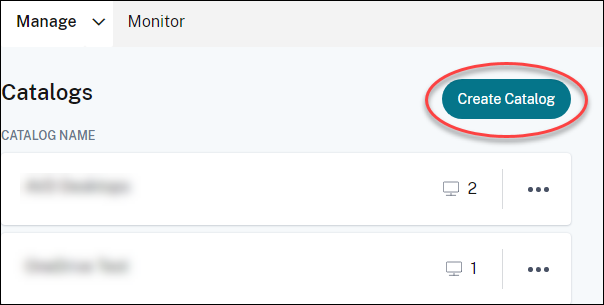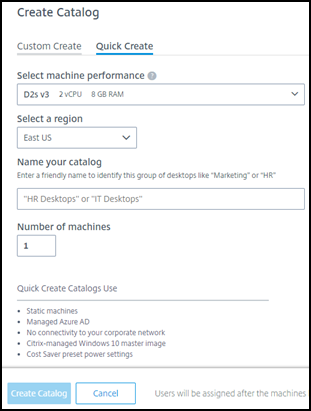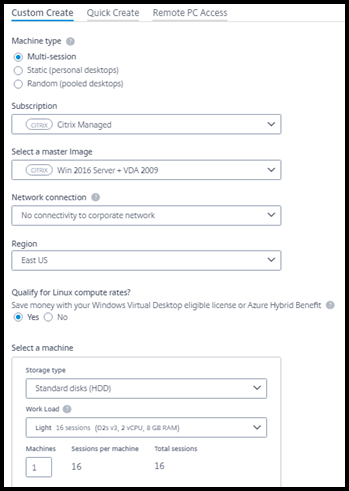Create catalogs
When used for published desktops and apps, a catalog is a group of identical virtual machines. When you deploy desktops, the machines in the catalog are shared with selected users. When you publish applications, multi-session machines host applications that are shared with selected users.
Note:
For information about creating Remote PC Access catalogs, see Remote PC Access.
Machine types
A catalog can contain one of the following types of machines:
- Static: The catalog contains single-session static machines (also known as personal, dedicated, or persistent desktops). Static means that when a user starts a desktop, that desktop “belongs” to that user. Any changes that that user makes to the desktop are retained at logoff. Later, when that user returns to Citrix Workspace™ and starts a desktop, it is the same desktop.
- Random: The catalog contains single-session random machines (also known as non-persistent desktops). Random means that when a user starts a desktop, any changes that that user makes to that desktop are discarded after logoff. Later, when that user returns to Citrix Workspace and starts a desktop, it might or might not be the same desktop.
-
Multi-session: The catalog contains machines with apps and desktops. More than one user can access each of those machines simultaneously. Users can launch a desktop or apps from their workspace. App sessions can be shared. Session sharing is not permitted between an app and a desktop.
- When you create a multi-session catalog, you select the work load: light (such as data entry), medium (such as office apps), heavy (such as engineering), or custom. Each option represents a specific number of machines and sessions per machine, which yields the total number of sessions that the catalog supports.
- If you select the custom work load, you then select from available combinations of CPUs, RAM, and storage. Type the number of machines and sessions per machine, which yields the total number of sessions that the catalog supports.
When deploying desktops, the static and random machine types are sometimes called “desktop types.”
Ways to create a catalog
There are several ways to create and configure a catalog:
- Quick create is the fastest way to get started. You provide minimal information, and Citrix DaaS™ for Azure takes care of the rest. A quick create catalog is great for a test environment or proof of concept.
- Custom create allows more configuration choices than quick create. It’s more suited to a production environment than a quick create catalog.
- Remote PC Access catalogs contain existing machines (usually physical) that users access remotely. For details and instructions about these catalogs, see Remote PC Access.
Here’s a comparison of quick create and custom create:
| Quick create | Custom create |
|---|---|
| Less information to provide. | More information to provide. |
| Fewer choices for some features. | More choices for some features. |
| Citrix-managed Microsoft Entra user authentication. | Choice of: Citrix-managed Microsoft Entra ID, or your Active Directory/Microsoft Entra ID. |
| No connection to your on-premises network. | Choice of: No connection to your on-premises network, Azure VNet peering, and Azure VPN gateway. |
| Uses a Citrix prepared Windows 10 image. That image contains a current desktop VDA. | Choice of: Citrix prepared images, your images that you import from Azure, or images you’ve built in Citrix DaaS for Azure from a Citrix prepared or imported image. |
| Each desktop has Azure standard disk (HDD) storage. | Several storage options are available. |
| Static desktops only. | Static, random, or multi-session desktops. |
| A power management schedule cannot be configured during creation. The machine hosting the desktop powers off when the session ends. (You can change this setting later.) | A power management schedule can be configured during creation. |
| Must use a Citrix Managed Azure subscription. | Can use the Citrix Managed Azure or your own Azure subscription. |
For details, see:
Create a catalog using quick create
This catalog creation method always uses a Citrix Managed Azure subscription.
- Sign in to Citrix Cloud.
- In the upper left menu, select Solutions > DaaS Standard for Azure.
- Navigate to Quick Deploy > Microsoft Azure.
-
Click Create Catalog.

-
Click Quick Create at the top of the page, if it is not already selected.

- Machine performance: Select the machine type. Each choice has a unique combination of CPUs, RAM, and storage. Higher-performance machines have higher monthly costs.
- Region: Select a region where you want the machines created. You might select a region that’s close to your users.
- Name: Type a name for the catalog. This field is required, and there is no default value.
- Number of machines: Type the number of machines you want.
- When you’re done, click Create Catalog.
You’re taken automatically to the Quick Deploy > Microsoft Azure dashboard. While the catalog is being created, the catalog’s name is added to the list of catalogs, indicating its progress through creation.
Citrix DaaS for Azure also automatically creates a resource location and adds two Cloud Connectors.
What to do next:
- If you’re using the Citrix Managed Microsoft Entra ID for user authentication, you can add users to the directory while the catalog is being created.
- Regardless of which user authentication method you use, after the catalog is created, add users to the catalog.
Create a catalog using custom create
If you are using a Citrix Managed Azure subscription, and plan to use a connection to your on-premises network resources, create that network connection before creating the catalog. To allow your users access to your on-premises or other network resources, you also need Active Directory information for that location.
If you do not have a Citrix Managed Azure subscription, you must import (add) at least one of your own Azure subscriptions to Citrix DaaS for Azure before creating a catalog.
To create a catalog:
- Sign in to Citrix Cloud.
- In the upper left menu, select Solutions > DaaS Standard for Azure.
- Navigate to Quick Deploy > Microsoft Azure.
-
Click Create Catalog.

-
Select Custom Create at the top of the page, if it’s not already selected.

-
Complete the following fields. (Some fields are valid only for certain machine types. The field order might differ.)
-
Machine type. Select a machine type. For details, see Machine types.
-
Subscription. Select an Azure subscription. For details, see Azure subscriptions.
-
Master image: Select an operating system image. For details, see Images.
-
Network connection: Select the connection to use for accessing resources in your network. For details, see Network connections.
-
For a Citrix Managed Azure subscription, the choices are:
- No Connectivity: Users cannot access locations and resources on your on-premises corporate network.
- Connections: Select a connection, such as a VNet peering or VPN connection.
-
For a customer-managed Azure subscription, select the appropriate resource group, virtual network, and subnet.
-
-
Region: (Available only if you selected No Connectivity in Network connection. ) Select a region where you want the desktops created. You might select a region that’s close to your users.
If you selected a connection name in Network connection, the catalog uses that network’s region.
-
Qualify for Linux compute rates? (Available only if you selected a Windows image.) You can save money when you use your eligible license or Azure Hybrid Benefit.
Azure Virtual Desktop benefit: Eligible Windows 10 or Windows 11 per user licenses for:
- Microsoft 365 E3/E5
- Microsoft 365 A3/A5/Student Use Benefits
- Microsoft 365 F3
- Microsoft 365 Business Premium
- Windows 11 & Windows 10 Enterprise E3/E5
- Windows 11 & Windows 10 Education A3/A5
- Windows 11 & Windows 10 VDA per user
Per user or per device license of RDS CAL with Software Assurance for Windows Server workloads.
Azure Hybrid benefit: Windows Server licenses with active Software Assurance or the equivalent qualifying subscription licenses. See https://azure.microsoft.com/en-us/pricing/hybrid-benefit/.
-
Machine:
- Storage type. Standard disk (HDD), standard SSD, or premium SSD.
-
Machine performance (for Static or Random machine type), or Workload (for multi-session machine type). Choices include only options that match the generation type (gen1 or gen2) of the image you selected.
If you select the custom work load, type the number of machines and sessions per machine in the Machine Performance field.
- Machines. How many machines you want in this catalog.
-
Machine naming scheme: see Machine naming scheme.
-
Name: Type a name for the catalog. This name appears on the Manage dashboard.
- Power schedule: By default, the I’ll configure this later check box is selected. For details, see Power management schedules.
-
- When you’re done, click Create Catalog.
The Quick Deploy > Microsoft Azure dashboard indicates when your catalog is created. Citrix DaaS for Azure also automatically creates a resource location and adds two Cloud Connectors.
What to do next:
- If you haven’t done it already, configure the authentication method for your users to authenticate to Citrix Workspace.
- After the catalog is created, add users to the catalog.
- If you created a multi-session catalog, add applications (before or after adding users).
Creating catalogs of Microsoft Entra joined machines
You can use custom create to create catalogs of machines joined to your Microsoft Entra ID. This is only supported in your own Azure subscription.
Requirements
Your deployment must include Citrix Cloud Connectors. Machine Creation Services™ deploys your Cloud Connectors based on the information you provide about your Microsoft Entra domain when you create a catalog.
This type of catalog can only be used to provision static or random machines. Provisioning of multi-session machines is not supported at this time.
Don’t join the master image to Microsoft Entra ID before creating a catalog. Citrix MCS joins the master image to Microsoft Entra ID when the catalog is created.
Use VDA version 2203 or higher.
In the Azure portal, assign the Virtual Machine User Login IAM role to the virtual machines in the catalog. You can do this in several ways:
- Most secure: If you are creating static machines, assign the role to the user assign to the machine.
- Alternate method: Assign the role on the resource groups containing the virtual machines, to all users with access to the catalog.
- Least secure: Assign the role on the subscriptions, to all users with access to the catalog.
Set Workspace authentication to use the Microsoft Entra ID you are joining to the machines in the catalog. For instructions, see Configure user authentication in Citrix Cloud.
For more information about requirements, known issues, and considerations, see the information about pure Microsoft Entra joined VDA configurations in Microsoft Entra joined and non-domain joined VDA configuration.
To create a catalog
- Sign in to Citrix Cloud.
- In the upper left menu, select Solutions > DaaS Standard for Azure.
- Select Quick Deploy > Microsoft Azure.
- Select Create Catalog.
- Select Custom Create at the top of the page, if it’s not already selected.
- Complete the following fields.
- Machine type. Select Static (personal desktops) or Random (pooled desktops).
- Subscription. Select your Azure subscription.
- Master image. Select an operating system image to be used for the machines in the catalogs.
- Network connection. Select the appropriate resource group, virtual network, and subnet.
- Domain configuration. Select Microsoft Entra ID as your domain type. A warning might appear reminding you to set Workspace authentication use this Microsoft Entra ID.
- Complete the remainder of the wizard to create the catalog.
Resource location settings when creating a catalog
When creating a catalog, you can optionally configure several resource location settings.
When you click Advanced settings in the Quick Deploy catalog creation dialog, Citrix DaaS for Azure retrieves resource location information.
-
If you already have a resource location for the domain and network connection selected for the catalog, you can save it for use by the catalog you’re creating.
If that resource location has only one Cloud Connector, another one is installed automatically. You can optionally specify advanced settings for the Cloud Connector you’re adding.
-
If you don’t have a resource location set up for the domain and network connection selected for the catalog, you’re prompted to configure one.
Configure advanced settings:
- (Required only when the resource location is already set up.) A name for the resource location.
- External connectivity type: through the Citrix Gateway service, or from within your corporate network.
- Cloud Connector settings:
- (Available only when using a customer-managed Azure subscription) Machine performance. This selection is used for the Cloud Connectors in the resource location.
- (Available only when using a customer-managed Azure subscription) Azure resource group. This selection is used for the Cloud Connectors in the resource location. The default is the resource group last used by the resource location (if applicable).
- Organizational Unit (OU). The default is the OU last used by the resource location (if applicable).
When you’re done with the advanced settings, click Save to return to the Quick Deploy catalog creation dialog.
After you create a catalog, several resource location actions are available. For details, see Resource location actions.
Machine naming scheme
To specify a machine naming scheme when creating a catalog using Quick Deploy, select Specify machine naming scheme. Use from 1-4 wildcards (hash marks) to indicate where sequential numbers or letters appear in the name. Rules:
- The naming scheme must contain at least one wildcard, but not more than four wildcards. All the wildcards must be together.
- The entire name, including wildcards, must be between 2 and 15 characters.
- A name cannot include blanks (spaces), slashes, backslashes, colons, asterisks, angle brackets, pipes, commas, tildes, exclamation points, at signs, dollar signs, percent signs, carets, parentheses, braces, or underscores.
- A name cannot begin with a period.
- A name cannot contain only numbers.
- Do not use the following letters at the end of a name:
-GATEWAY,-GW, and-TAC.
Indicate whether the sequential values are numbers (0-9) or letters (A-Z).
For example, a naming scheme of PC-Sales-## (with 0-9 selected) results in computer accounts named PC-Sales-01, PC-Sales-02, PC-Sales-03, and so on.
Leave enough room for growth.
- For example, a naming scheme with 2 wildcards and 13 other characters (for example,
MachineSales-##) uses the maximum number of characters (15). - Once the catalog contains 99 machines, the next machine creation fails. The service tries to create a machine with three digits (100), but that would create a name with 16 characters. The maximum is 15.
- So, in this example, a shorter name (for example,
PC-Sales-##) allows scaling beyond 99 machines.
If you do not specify a machine naming scheme, Citrix DaaS for Azure uses the default naming scheme DAS%%%%%-**-###.
-
%%%%%= five random alphanumeric characters matching the resource location prefix -
**= two random alphanumeric characters for the catalog -
###= three digits.